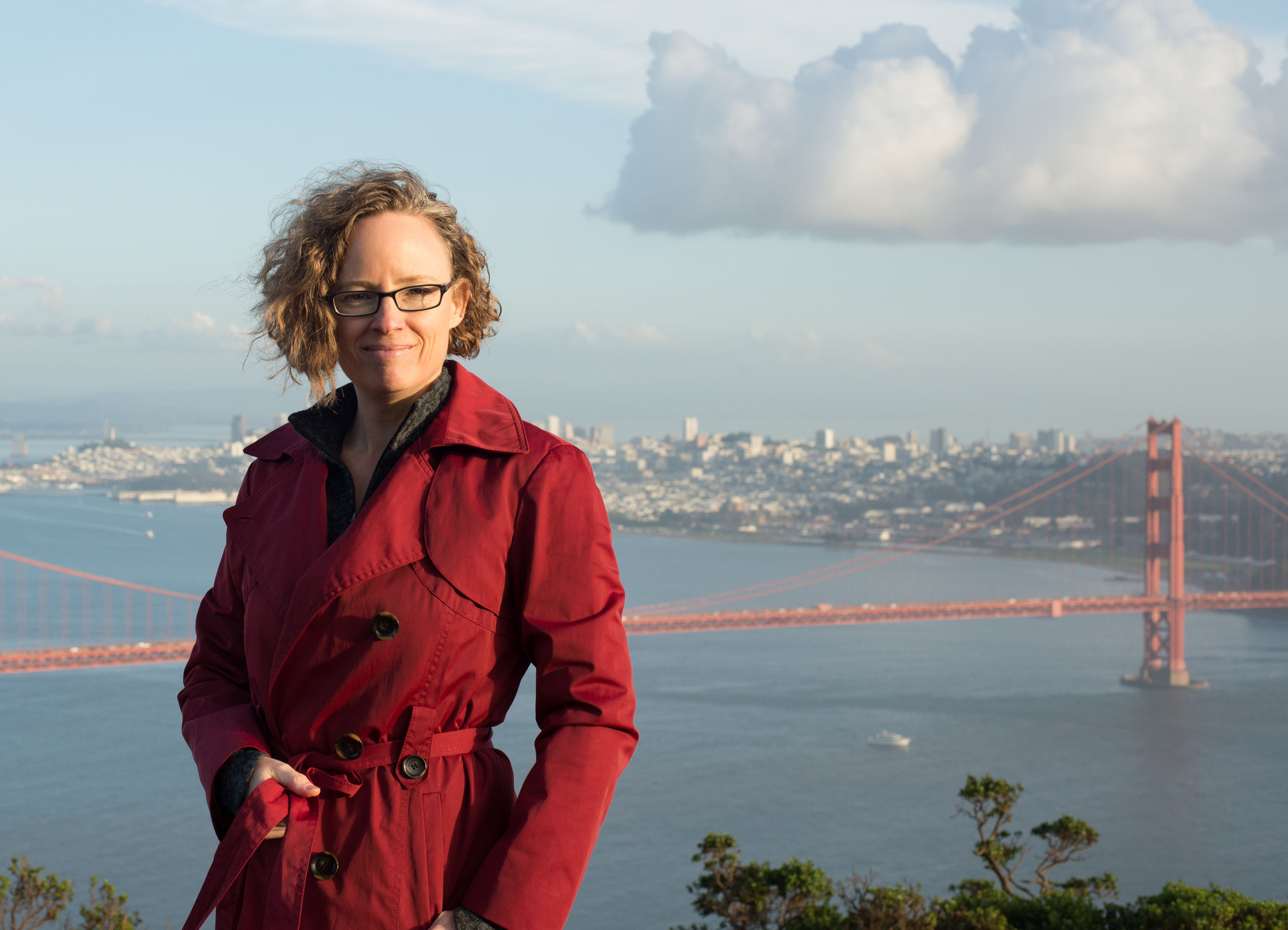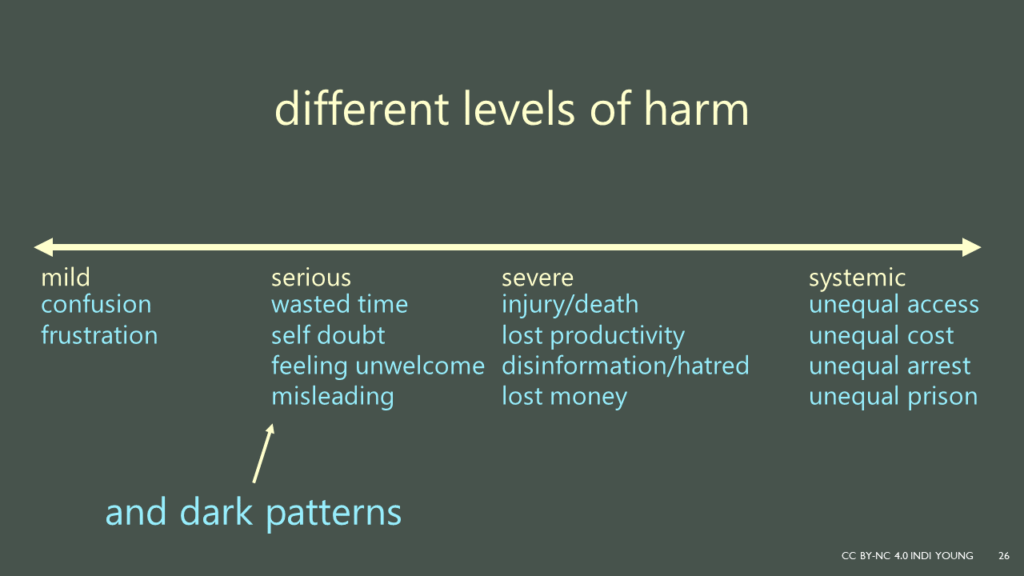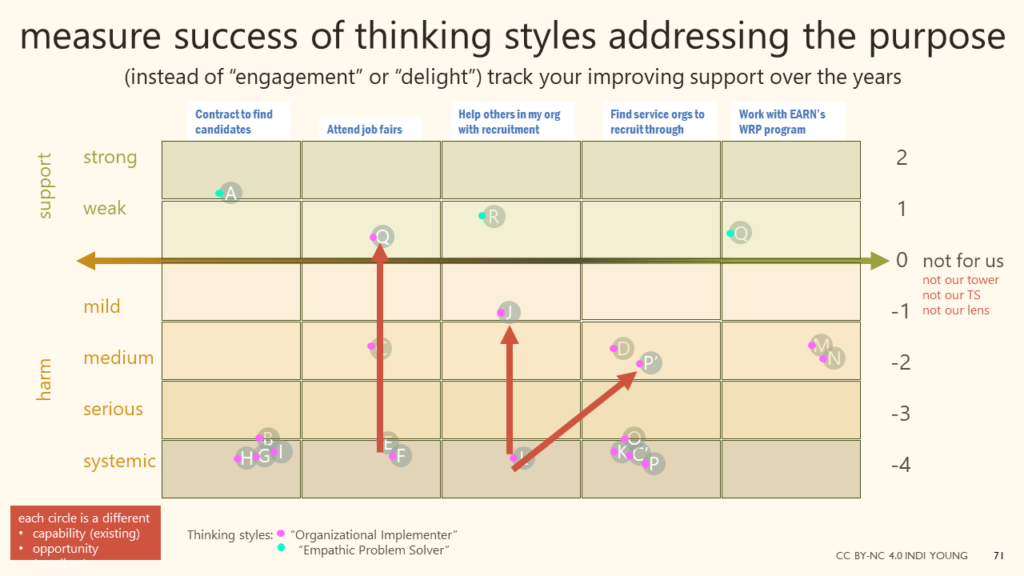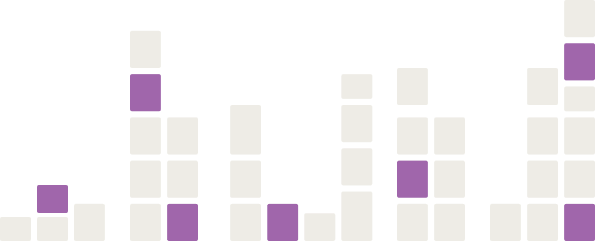
30 years of growing this method
Product & service design teams rarely get that sense of actually making things better for people. They feel trapped in endless cycles. Leaders wonder why the solutions don’t capture the market.
Is it the method?
Yes! Defining “user needs” from the lens of the solution is circular. It grazes the surface of knowledge you need. Quick data analysis invites bias. You need dimension instead of an “average user.” Problem space research lets you leap out of these traps.
Supporting humans is more important than creating solutions
Yeah, that sounds weird, doesn’t it? It’s not. Digital service and product design is caught up in methods that focus mostly on measuring the success of the solution, not the success of the human.
We are not paying attention to the more serious harms we unintentionally cause, like self-doubt and feeling unwelcome. Rather than waiting for lawsuits, we should be looking at potential severe harms, like loss of health, freedom, life, money, or time. What about intentionally mapping out systemic harms that our solutions perpetrate?

Generating respect, dignity, and a sense of making progress in community with others–those are what lives are made of. And those are what get crushed in the zeal to push technology forward.
Indi is a technologist, but not a solution-ist. The tool she reaches for most often is deep listening. She’s one of the people molding our methods to a more human shape. She is spreading the idea of paying attention to people. Indi helps you support humans, rather than simply create tools.
Indi gives practitioners and leaders powerful mindsets and awareness. Depending on their own context, developers, product owners, designers, researchers, and leaders can adjust these mindsets and awareness to best work within their organization.
Harness the mindset of supporting humans.

For the past three decades Indi has provided organizations with the knowledge to face the future with confidence and excitement. She can help your team truly see beauty in the complexity of humans and support many different perspectives.
Research for ethical product strategy
We can’t go on solving things only based on our own thin understanding. Even if we have diverse teams, our ideas are based on our own experiences. Who speaks for everyone else out there who may think and react differently? It’s time to bring ethics to bear. And to do that, deeper knowledge is needed. Problem space research provides that knowledge, and is deeply similar to futures research, opportunity research, foundational research, and exploratory research.
It’s time to
“Woke” in the Technology Workplace
Right now in the technology world, broad representation of cultures, histories, and values among teams is rare. We’re working on improving this, actively seeking the people who have been excluded from chances others have access to.

Advocate & Create Trust
Though at first daunting, it’s possible to help stakeholders shed years of assumptions, and trust the value of problem space research.
We are a solutions culture. Our first impulse is to come up with ways to fix things. Dropping this impulse for a moment, taking time to listen deeply, is the way to develop trust. With stakeholders, this means learning how they think, building your understanding of their concerns, and making them feel heard. Over time, you will have built their trust, which they will extend to you.
You can also develop trusting relationships with your peers at work. You can develop trust with customers. And best of all, you can develop trust with people who you’d never thought of before. With all this trust, with this deep knowledge, you can then turn on your fixing-things ideas.

Indi’s Bio
[short version] Indi is a problem-discovery researcher who makes tools that support inclusive and responsible solutions for a broader variety of thinking styles. She teaches courses online, writes books & essays, presents talks and does podcast appearances, and pens helpful posts on LinkedIn.
[official version] Indi is a solution strategist who uses purpose-focused qualitative data science. She created her method over a 30-year span, and teaches that method in courses, coaching, workshops, books, talks, and through working with teams on research studies.
She spends the majority of her time helping spread techniques, confidence and humanity among UX and Product practitioners. Indi also runs research project for clients, and coaches teams through their research studies. Indi teaches applied research skills such as listening and qualitative data synthesis through courses and Live Practice hosted on her website.
Indi’s method is focused on people, not users.
She pioneered opportunity maps, which are mental model diagrams of people’s approach to a purpose aligned with the support a solution provides–or doesn’t. She helps teams map thinking styles with careful attention to resisting assumptions and representing the interior cognition of people in their own context. Teams can then measure the level of harm they cause to approaches that are outside the org’s assumptions.
Indi intends to help the field move toward creating a variety of solutions to the same purpose, in support of the variety of thinking styles people have.
Indi has written three books, Time to Listen, Practical Empathy and Mental Models. She is at work on another book in the series, Assumptions Aside, that will cover thinking styles.
She was one of the founders of Adaptive Path, the pioneering UX agency.
You can follow Indi on LinkedIn, Twitter (@indiyoung) and Bluesky (@indiyoung.bsky.social), access many resources on her website indiyoung.com and at her Medium.
Indi’s Accomplishments
- Indi has given over 50 presentations at public conferences globally (8 of these were keynotes), and she has given 16 presentations at private conferences (6 of which were keynotes). Indi has been a guest on 37 shows and met with 111 small groups as a part of her effort to be there for meetups, learning orgs, and team chats.
- 2023: It took almost the whole year to create the jewel of the courses, Part 2: Qualitative Data Synthesis (Cultivate Emergent Patterns). Indi runs a Practice Group on the topic at the end of the year. Amyris Fernandez and team finish the translation of Time to Listen in Portuguese, and it is published in Brazil & Portugal.
- 2022: Indi edits and publishes the book Time to Listen, and converts the first two courses to short videos with closed captions, materials, and online quizzes, as well as a Live Practice Group Meeting format. She continues to speak and appear as a guest on podcasts.
- 2021: Indi writes the first draft of a third book, Time to Listen, and polishes the concepts and content of the online courses in preparation for an updated, more accessible format; works with client to produce employee thinking styles
- 2020: counts the 58th opportunity map Indi has created for a client
- 2018: Indi begins building a series of live online training about listening skills, synthesis, creating mental model diagrams & thinking-style segments; she adopts the term “opportunity map” suggested to her by several practitioners at big tech companies.
- 2016: Indi narrates Practical Empathy for Audible.
- 2015: Indi’s second book, Practical Empathy, is released.
- 2008: Indi begins offering workshops to organizations; she continues to do freelance research for clients.
- 2008: Indi’s book Mental Models is published as the first Rosenfeld Media book, introducing the problem space research method to a wider audience
- 2006: Indi returns to her own freelance consulting, doing research studies, mental model diagrams, and gap analysis for many clients.
- 2001: Indi is a founding partner of Adaptive Path, the pioneering UX agency responsible for knowledge sharing via many channels, notably the much-loved UX Week conference. Indi conducts research, creates mental model diagrams, and teaches everyone she can how to see opportunities in the gaps between the mental models and the business capabilities meant to support them.
- 2000: Indi draws the first version of a mental model diagram, to show a client how their product supported (or didn’t support) their B2B customers (geospatial data).
- 1997/99: Indi polishes her practice of non-directed interviews with people who are addressing their purpose; to appeal to product and business managers, Indi transitions from “conceptual model” to “mental model,” a representation of what the users are trying to accomplish and how they can accomplish it, looking beyond just the tool design.
- 1996/97: Indi works for a year as a UX designer for Ikonic, and introduces UI models to the directors, developers, and PMs there; she flips from top-down structure to bottom-up, because the top-down, ivory tower (“cloth office cube”) approach does not take into account the real-life breadth of “atomic tasks;” she creates functional documents for UI based on “conceptual models” made up of these atomic tasks
- 1996: Indi evolves the task model to a “UI Model” for Colloquy, intrigued by the “task analysis” method from part of a BayCHI talk given by researchers from the Stanford Knowledge Systems Lab.
- 1993: Indi is determined to shift bank stakeholders to focus on the user, and creates a state machine of Visa call center reps tasks as they transition a desperate cardholder from having lost their card to gaining a replacement; stakeholders grasp the state machine as a less-complicated way to understand the system requirements (a 321-page document).
- 1992: Indi begins freelance work, starting with apps in the PenPoint tablet by Go (early handwriting recognition).
- 1989: Indi moves into interaction design, in Unix, during the Motif vs XToolkit+ competition.
- 1987: Indi begins her career as a software engineer.
- 1987: Indi starts her masters in Computer science at CSU Fort Collins, then quits because she wanted to push interaction design forward. (This was before any UX programs existed!)
- 1987: Indi gets her degree in Computer Science from Cal Poly San Luis Obispo
Website Credits
- Website design & logo: Yousef Kazerooni
- Sketches: Anna Iurchenko
- Photos: Laurie B Photography and Indi Young
- Site coding: David Rodrigues and Nathan Boole
- App coding: Jorrit Poelen
